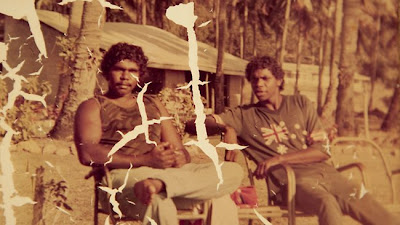The Tall Man does suffer from some slight structural problems – it never seems confident in the story it was trying to tell. Was it Cameron Doomadgee? Was it Sergeant Hurley’s? Was it Palm Island’s? It tries to tell them all, and with the exception of Cameron’s, it doesn’t quite go deep enough in the relatively slim 79 minutes and I felt like it padded the running time by repeating images and accounts. Still, the complex way it delves into the coronial inquests and reveals the impact that the event has on the island’s atmosphere and specific members of Cameron’s family (his son, for example) and involved members of the community is at times even more shocking than Cameron’s death. It is documented and presented with such clarity that it is impossible not to get absorbed.
I also don’t think we learnt enough about Hurley, especially considering how he is set up initially as the feared ‘Tall Man’ in the title. Due to fears for his safety following the event he was sent off the island - the only testimony we are given are the video reenactments the day following the event, and recorded testimonies from the trial. Even his life before Palm Island is courtesy of entirely accounts – both defending his character (‘a gentle giant’, a ‘highly commendable Police Officer’ and a man ‘well-respected within the community’) and defaming his character (apparently there had been prior incidents with the family of Cameron Doomadgee and one of the chief witnesses). The riot, which involved angry members of the local community burning the police station and Hurley’s home following what they believe to lies and a cover-up, brought the story to the Nation’s front pages.
I also don’t think we learnt enough about Hurley, especially considering how he is set up initially as the feared ‘Tall Man’ in the title. Due to fears for his safety following the event he was sent off the island - the only testimony we are given are the video reenactments the day following the event, and recorded testimonies from the trial. Even his life before Palm Island is courtesy of entirely accounts – both defending his character (‘a gentle giant’, a ‘highly commendable Police Officer’ and a man ‘well-respected within the community’) and defaming his character (apparently there had been prior incidents with the family of Cameron Doomadgee and one of the chief witnesses). The riot, which involved angry members of the local community burning the police station and Hurley’s home following what they believe to lies and a cover-up, brought the story to the Nation’s front pages.
Palm Island, to the indigenous residents, is a tropical paradise in Australia’s far North. Apart from documented footage such as this – and the death, the riot and subsequent trials would have brought media to the Island – it is largely unseen. For a while Krawitz focuses some attention on the Island, providing stunning shots of its beautiful coastline and impoverished domestic housing and relaying some worrying statistics about its residents (the unusually high rate of domestic abuse and suicide on the Island etc.) but it’s not really enough to declare it a probing study.
The centre of the film is the tragic death, the frustrations surrounding the trial and the constant battle between Palm Island residents and the Queensland police who repeatedly deny Hurley’s involvement and at one point threaten to strike in response to a decision made by the Queensland Government – and this is where the film is very successful. Krawitz interviews Cameron’s family, while witnesses from the day tell their individual stories. Krawtiz also interviews a host of legal and medical professionals – including members of Palm Island’s legal counsel who fought to accumulate the evidence necessary to put Hurley on trial, a prominent Queensland journalist who covered the case, a medical practitioner on the Island who established that the injuries couldn’t have been caused by a fall as claimed and even Chloe Hooper, the novelist whose award-winning non-fiction book serves as the basis for the film.
An effective score accompanies the images and I really like the way the film ended. While it made it pretty clear that Hurley was likely responsible for Cameron’s death and for the trauma placed on the family (though he was found not-guilty and remains a working member of the Queensland Police Force), it also justified that it wasn’t a crime brought about by hate or racism – but perhaps the result of a man who had finally reached a breaking point. It seemed like Cameron’s drunken behaviour, and the fact that he allegedly punched Hurley, put him in the company of a much larger man at the wrong time and resulted in regrettable tragic circumstances. The fact that Hurley tried to recreate the event and blamed the man’s injuries on a fall – and the way that the Palm Island Police Force, and in extension the Queensland Police Force, handled the case (assuming impunity) was what roused the most emotion. This extremely powerful documentary is compelling, thought provoking, skillfully told and likely to resonate with any Australian viewer. It’s an undeniably important insight into a tragic chapter of Queensland history.
My Rating: ★★★★ (B+)



No comments:
Post a Comment